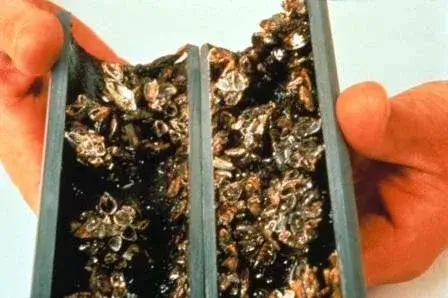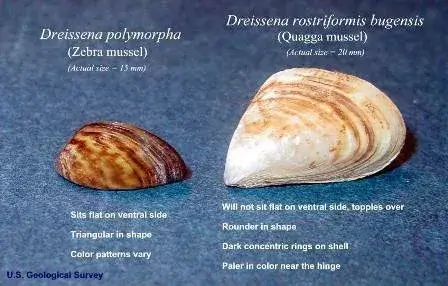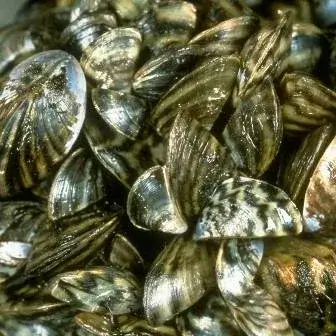
(Dreissena polymorpha)
This clam-like bivalve mollusk, commonly called the zebra mussel, Dreissena polymorpha, is a native of the Ponto-Caspian region of Eastern Europe and western Asia—the Black, Caspian, and Aral Seas, and the Ural River drainage. It was introduced into several European freshwater ports during the late 1700s; within 150 years Dreissena was found throughout European inland waterways. Dreissena was first found in the Great Lakes in Lake St. Clair in 1988, where it is believed to have been introduced as the result of the discharge of freshwater international shipping ballast water.

While there is still some disagreement as to whether the zebra mussel was introduced in a single location or whether the North American population is the result of multiple introductions in various locations over a number of years, what is certain is that once established in the Great Lakes, the zebra mussel spread rapidly across the eastern half of the continent, reaching 23 states and two provinces in only 15 years. Once established in the lakes, the mussel spread via intra- and interbasin ballast water movement; attachment to commercial ship and recreational boat hulls and boat trailers; movement of construction equipment; larvae carried by currents, in bait buckets and in recreational boat live wells; commercial bait and aquaculture shipments; and, natural movement in lake and river currents and flows. Zebra mussels have now crossed the 100th Meridian and are now found in 25 states nationwide.

Zebra mussels are small (generally under 5 cm), with elongated shells typically marked by alternating light and dark bands. Eggs (as many as one million per season per female) are fertilized outside the body in the spring or summer. Larvae (veligers) are free-swimming for up to 30 days, being dispersed by currents. Juvenile mussels settle to the bottom and attach to suitable hard substratum (rock, wood, shells of native mussels, and human-made surfaces such as concrete, steel, fiberglass, etc.) by secreting durable elastic strands called byssal threads; if no hard substrate is available, zebra mussels will also attach to vegetation. The mussels are generally found within 2 to 7 meters of the water surface but have been found as deep as 50 meters. Zebra mussels will colonize lakeshores and riverbanks where they attach to rock or gravel substrates, forming broad mats up to 10 to 15 cm in thickness. Colony densities may reach 20,000 per square meter. Extensive colonization of shoal areas could impair the reproduction of species of fish (such as walleye and lake trout) that spawn only on rocky-bottomed areas.
Zebra mussels are filter feeders, capable of filtering up to two liters of water per day per adult, feeding on phytoplankton, small zooplankton, detritus, and even bacteria down to approximately the one-micron size range. Such filtration can dramatically increase water clarity and significantly reduce lake productivity, changing aquatic plant and animal habitat value. It has been estimated that the zebra mussel population of the western basin of Lake Erie has the capability of filtering the entire volume of the basin daily. Since phytoplankton and detritus are major food sources for pelagic lake and riverine food webs, fisheries-related impacts can result from zebra mussel filtration activity. Excessive removal of phytoplankton, detritus and small zooplankton from the water column can result in a decline in zooplankton species that feed upon those food particles. Larger zooplankton species and larval fish of all species preying on smaller zooplankton face reduced survival as mussel populations expand. Changes in water transparency can favor a shift towards increased production of benthic algae.
Because of an affinity for water currents, zebra mussels extensively colonize water pipelines and canals, such as those in drinking water treatment plants, industrial facilities and electric power generation plants. Once inside an intake, the mussels are protected from predation and the ravages of the weather, resulting in very large densities of mussels (one Great Lakes power plant canal had up to 750,000 mussels per square meter). Such mussel growth can severely reduce water flow, result in a loss of intake head, obstruct valves, clog condensers and heat enchangers, result in noxious tastes and smells in treated water, produce nuisance methane gas, and increase electro-corrosion of steel and cast iron pipelines. Zebra mussels attached to a commercial or recreational vessel’s hull increase drag and fuel consumption. Recreational use of beaches is impacted by the colonization of cobble in nearshore areas and by littering of beaches by shells washed up by storm waves. Bathers on Great Lakes beaches have adopted the use of beach/bathing footgear to prevent cuts from zebra mussel shells. It has been estimated that since their introduction into North America, zebra mussels have caused $1 billion to $1.5 billion worth of economic harm.


(Dreissena rostriformis bugensis)
Originally thought to be a variant of the zebra mussel (D. polymorpha, see species profile, above), the quagga mussel (nicknamed after a now-extinct zebra-like quadruped), is now known to be genetically a separate, distinct species. For the general description of introduction, range expansion, and ecological and physical impacts, see the discussion in the profile of D. polymorpha. Zebra mussels possess a distinctly flattened ventral (hinge) surface as compared to the same side on quagga mussels, which presents a smoothly rounded surface. A simple field test to distinguish the two as large adult specimens is that a zebra mussel will usually sit upright on its ventral side, whereas a quagga mussel will tip over. On smaller mussels, with shells that have not finished forming, this is not a definitive test. A second test is that the valves (shell halves) on zebra mussels are symmetrical with the two valves meetings along a straight line, whereas on quagga mussels they are asymmetrical, with the two valves meeting along a curved line.

Quagga mussels have been found to be able to survive and colonize in areas of soft substrate, such as sandy or silty lake bottoms, whereas zebra mussels that settle onto such bottoms usually do not survive. D. polymorpha is more tolerant of warm temperatures than is D. bugensis, capable of sustaining water temperatures of 30°C for extended periods of time and up to 39°C for several hours, while D. bugensis has an upper thermal tolerance limit of approximately 25°C. D. bugensis appears more efficient at growing under lower water temperatures than D. polymorpha. Quagga mussels can filter and incorporate food down to the sub-micron level, thereby including bacteria too small for zebra mussels or native clams and mussels to consume, giving the quaggas a competitive advantage over zebra mussels and native species when levels of larger plankton are too low to sustain large populations. There are no apparent salinity tolerance differences between the two species, each having chronic salinity tolerance levels of approximately 2 parts per thousand, allowing some, but not much, range expansion into tidal estuaries.
A marked distribution replacement of D. polymorpha by D. bugensis is taking place in the Great Lakes; since the mid-1990s, D. bugensis has almost totally replaced D. polymorpha in Lakes Erie and Ontario, to the extent that the original zebra mussels are now very rare in most of eastern Lake Erie and throughout Lake Ontario. It is theorized that this might be due do the quagga mussel’s ability to colonize softer substrates than zebra mussels, to the quagga’s ability to grow more efficiently in colder water temperatures than zebra mussels, particularly in deeper waters, and to the quagga’s more efficient feeding capability.
